Museum-City Évora: 17 best things to do in Évora, Portugal
This post may contain affiliate links. If you use these links to buy something I may earn a small commission at no extra cost to you! Thank you for your support!
Let’s explore the best things to do in Évora, Portugal! With its rich architecture and well-preserved historic center, Évora has earned the nickname “The Museum-City”. Let me tell you—the Historic Center of Évora, a UNESCO World Heritage, truly felt like an open-air museum!
The city of Évora is one of the best destinations for day trips from Lisbon, so we traveled there and spent two days exploring everything this historic city had to offer—from the ancient Roman Temple, a chapel built with human bones to megalithic sites that are thousands of years old.
If you have extra time to spend near Lisbon, Évora is a good choice for those who appreciate medieval architecture and historical monuments. In this blog post, you will find the top things to do in Évora with photos, descriptions, and locations on Google Maps. Happy exploring!
Read more » Nazaré, Portugal: 15 ultimate best things to do in Nazaré
1. Visit the famous Chapel of Bones in Évora!

Chapel of Bones is one of the most unique hidden gems in Portugal and, one of the main attractions in Évora. I was really keen to see the famous Capela dos Ossos chapel with inner walls, pillars, and ceiling arches lined with human bones and skulls. Crazy!
The Chapel of Bones is part of the Museum of Évora. The ticket costs 6 EUR and includes visits to the Évora Museum with its vast collection of religious objects, the Chapel of Bones as well as the church of São Francisco.


The Chapel of Bones is a built-in room inside the premises of the monastery and church complex. It is a single room lined with multiple pillars, Portuguese tiles, frescoes that decorate the vaulted ceiling as well as bones from about 5,000 skeletons.
It is a strange feeling for sure, however, I tried to look at it as part of our historic heritage. This was something people did in those days and it has to be looked at through their perspective, not mine, so then it was easier to take it all in!


The Chapel of Bones was built in the 17th century and is the star of the museum. If you are wondering where all the bones came from, then there isn’t a special story – Franciscan monks took them from the exhumated corpses from the medieval cemetery in Évora.
Another interesting part about the Chapel of Bones is the inscription above the entrance that says ‘Nós ossos que aqui estamos pelos vossos esperamos‘ and translates from Portuguese as ‘We, the bones that are here, for yours we wait’. Creepy?


After visiting the chapel, you can embark on a long quest through the rooms and hallways of the museum. It is lined with religious items from all around the world. At first, I paid attention to everything until it became too much.
As you walk through every room, at one point you will walk outside on the balcony where you get some nice views over the city. However, it is not too high so the view is limited. Once you finish the museum, you can then head to the church of São Francisco.


São Francisco church dates back to the 15th century and boasts a Gothic architectural style blending in some Moorish elements. The church has a single vaulted nave and twelve chapels along the sides of the nave.
I suggest dedicating at least 1 or 1.5 hours to visit all the places here. If you are short on time you can skip the museum and visit the Chapel of Bones and the church. This is definitely one of the must-see places in Évora that you should not miss!
Location: Chapel of Bones
2. Climb on the roof of the glorious Cathedral of Évora!


Although the Chapel of Bones was very intriguing and it was the one place that made me go on a trip to Évora, I was actually most excited about visiting the Cathedral of Évora. I absolutely love centuries-old cathedrals with rich and impressive architecture!
The Cathedral of Évora definitely did not disappoint! Awarded as the biggest medieval cathedral in Portugal, it is a majestic sight to witness! It is also one of the most important examples of Gothic architecture in Portugal.
The construction of the cathedral started in the 12th century when a modest version of the cathedral was built. However, over time, it was enlarged and added new parts to the complex until its completion in the 18th century.
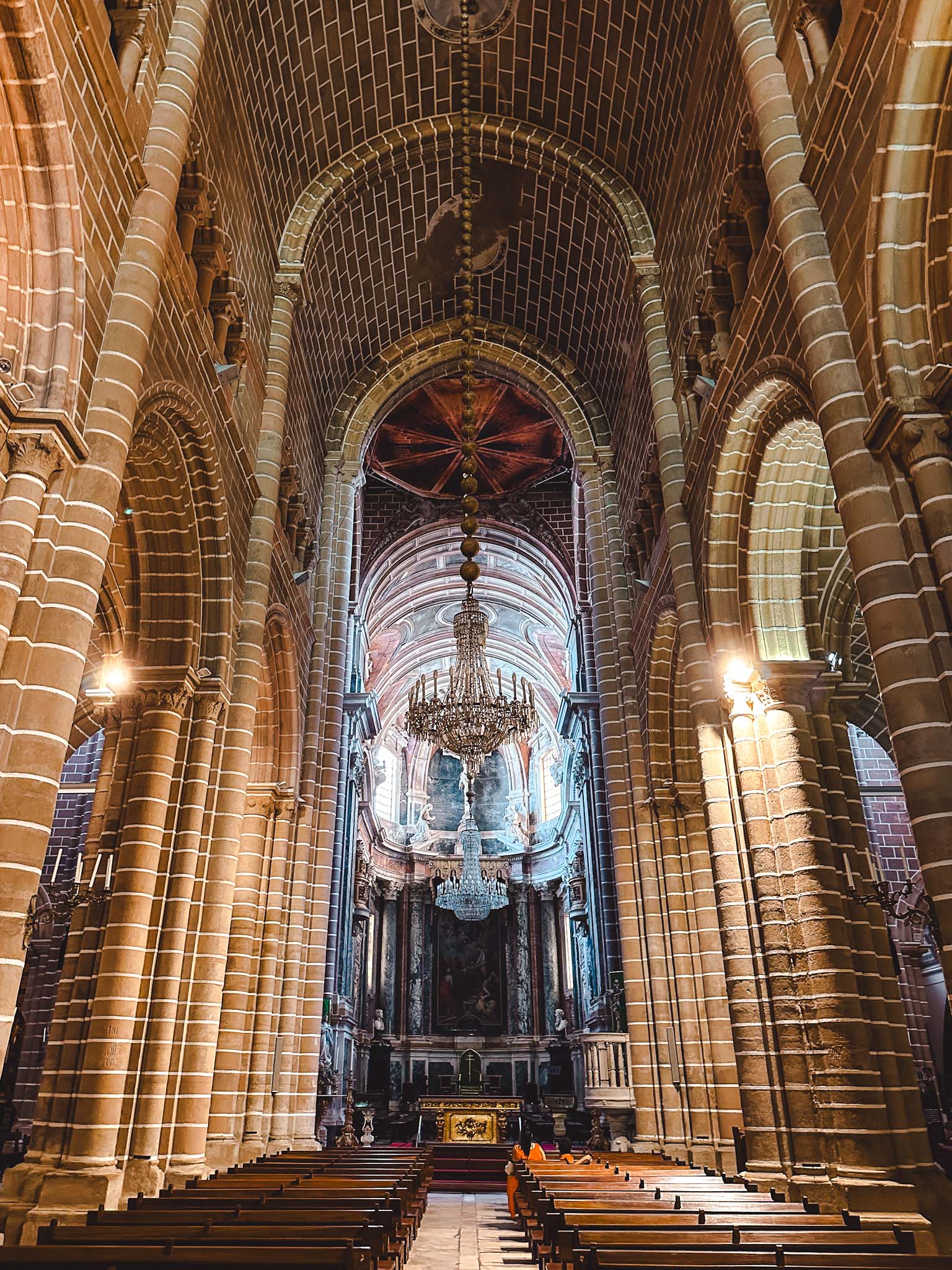

We paid 3.50 EUR per person for the entrance and those were the best-spent 7 euros in Évora for us. You can check the prices of the Cathedral of Évora on their website. There is a possibility to visit a museum as well, but we skipped this option.
The entrance fee (excluding the museum) permits you to climb up to the roof of the cathedral which was one of my favorite things to do in Évora! You also get to see the church as well as walk around the cloister, a rectangular courtyard attached to the cathedral.
Climbing up to the roof of the cathedral was my favorite thing to do in Évora. You have to climb up at the very beginning of the visit. You can walk around the rest of the building afterward.


I love climbing up to the rooftops and this was one of the most beautiful rooftops I got to visit in Portugal! There is some decent competition with some amazing rooftops to visit in Lisbon however the Cathedral of Évora wins overall!
Once you are on the roof, you will notice that the cathedral has a very striking and picturesque lantern tower with multiple spires. It seems like it came out of a fairytale! The rooftop is the highest place in Évora where you can get panoramic views over the entire city center.
After the visit to the rooftop, you can then climb back down and explore the rest of the complex – the church, walk around the cloister, climb up to the roof of the courtyard building, and visit the rooms around the perimeter.
The cathedral was my favorite place in the beautiful Évora, the capital of the Alentejo region! The visit will take at least one hour as there is a lot to admire. This was a highlight of our visit and is definitely amongst the most beautiful places in Portugal!
Location: Cathedral of Évora
3. Admire the ancient Roman Temple of Évora!

The impressive Roman Temple of Évora, also known as the Temple of Diana, was built in the 1st century and is around 2,000 years old. Such a unique place in Évora! You can visit the famous Roman ruins for free—they are in a public square a short distance from the cathedral.
The temple was built in honor of the first Roman Emperor Augustus and at that time, it was located in the main square of Évora. It is one of the most important landmarks to visit in Évora. I love how you can see the tower of the cathedral in the background of the temple!
Location: Roman Temple of Évora
4. See the view from the Garden of Diana viewpoint!

Right next to the Roman Temple of Évora, you will find the Jardim Diana Park. It is a small green area with a couple of trees and benches to sit on. We bought some ice creams next to the park and came here to sit down and take a breath (it was a hot day!).
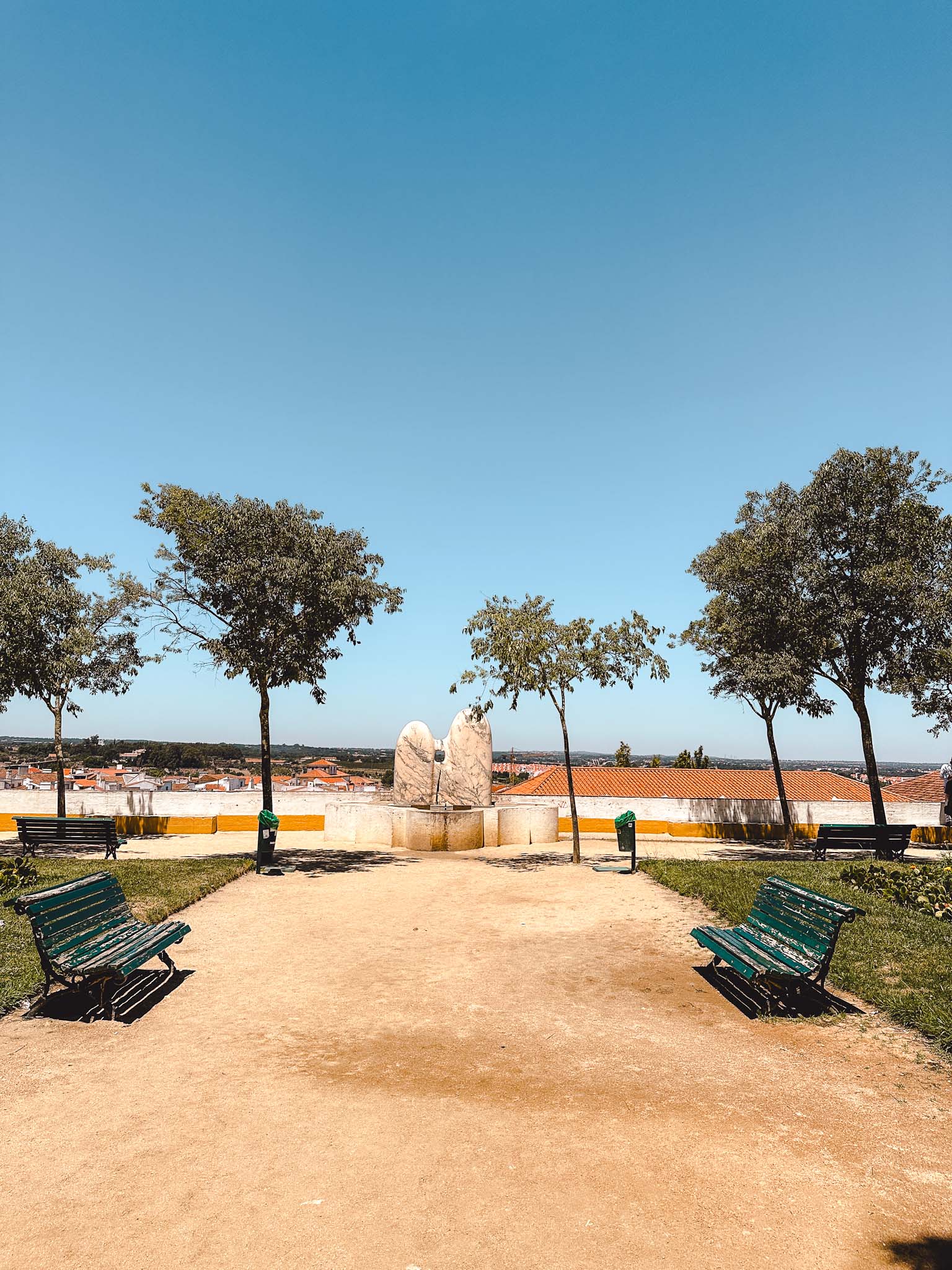
My favorite part of this park is that at the end of it, there is a viewpoint overlooking Évora city. Although nothing beats the views from the roof of the Cathedral of Évora, this cool spot is just a few meters from the Roman Temple of Évora so check it out!
Location: Miradouro do Jardim de Diana
5. Indulge in local delicacies at Pastelaria Conventual Pão de Rala!
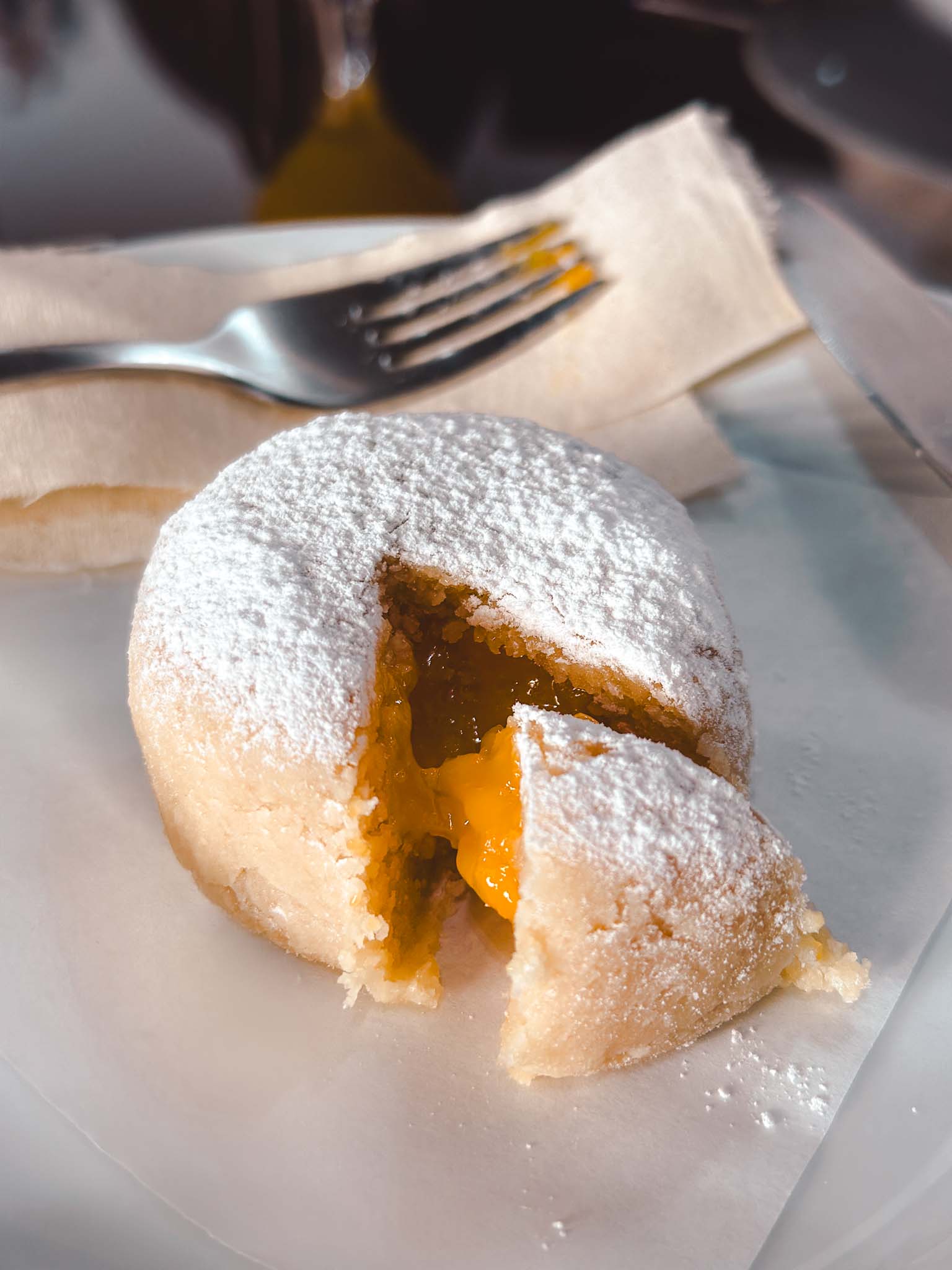

A short stop at Pastelaria Conventual Pão de Rala pastry shop is one of the things you should not miss when visiting Évora. I stumbled upon this place by accident and immediately wanted to visit it. You can always find time to taste delicious food from local cuisine!
I saw the good reviews and decided to give it a go! It did not disappoint! I have to admit that we were a bit hungry from all the walking and exhausted because of the high temperatures and heat, but, still, somehow everything here tasted fantastic!

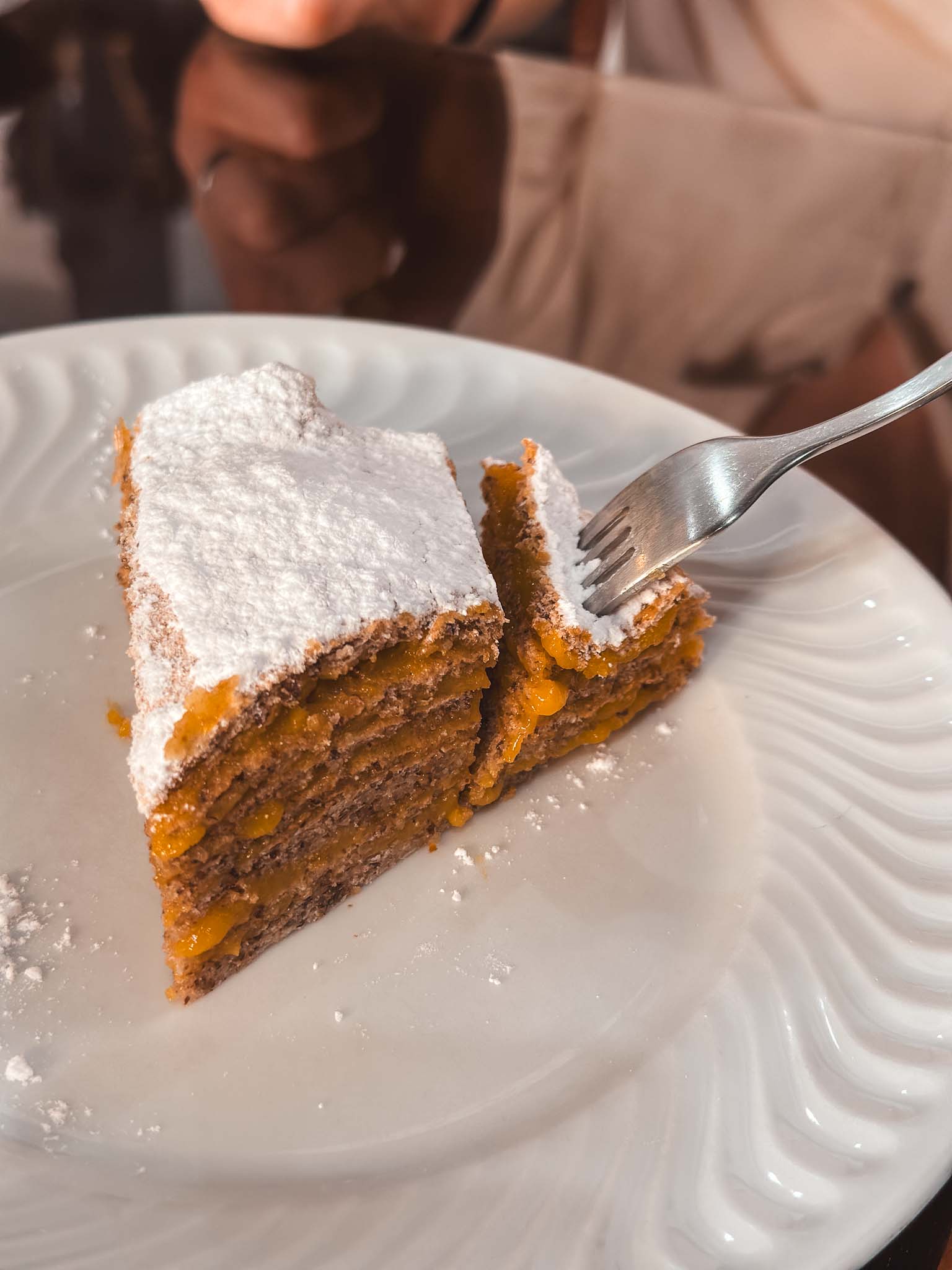
Pastelaria Conventual Pão de Rala pastry shop offers traditional sweets and pastries from Évora and the Alentejo region. I have to apologize as I don’t remember the names of these sweets but they all tasted great!
Many of the traditional sweets consist of almonds and egg yolk filling which is something typical in Portugal. As you know, the famous pastel de nata is also made of egg yolk cream. I recommend trying as many different pastries as you can here!
Location: Pastelaria Conventual Pão de Rala
6. Explore the unique rooms and halls of the University of Évora!


One of the most unusual places to explore in Évora was the University of Évora. It was established in the 16th century and thus is the second oldest university in Portugal. It is known for its architecture and tile-covered classrooms and halls.
For an entrance fee of 3 EUR, you get to explore the whole building. There is a large arch-lined courtyard with a hallway and classrooms around the perimeter. Each of the classrooms has tile illustrations on the walls.


Each room is dedicated to a different subject like geography, physics, and so on. Each room is filled with tile illustrations that depict stories and moments from the corresponding theme e.g. geography classroom will have tile illustrations related to geography.
There are beautiful tile illustrations on the walls outside in the courtyard as well. You can explore two floors of rooms and halls. I especially liked the gathering hall with beautiful paintings and decorative tiles. This is a fun place to visit if you have extra time in Évora.


I have to mention that we visited Évora during the summer do there were no classes at that time and it was practically empty. We could open every door and explore all the beautiful tiles in the building.
However, if you go to Évora during the school year (that would be from the beginning of September to the beginning of June) then visiting classrooms may turn out more difficult. You might have to wait until the classes are done to see them.
In that case, I’m not sure if it is worth paying 3 EUR to just walk around the courtyard. If you still want to check it out, you can go to the entrance and ask at the reception about the situation and maybe they have the class schedule for that day so that you can make a better decision!
Location: University of Évora – Entrance to the university
7. Admire the tiles and gold at Igreja da Misericórdia!


Igreja da Misericórdia is one of the most beautiful places in Évora. For a small entrance fee, you get to visit a museum of religious art and one of the most beautiful churches in Évora. Lined with gilded art and Portuguese tiles, it is a unique sight to see!
Notice, that the entrance is not through the main door of the church but from the side (exact location below). I was not too impressed by the museum part as there are only some small objects related to church and religious activities.


However, the church was a beautiful surprise. The main nave consists of four parts – wooden chairs and a floor, a lower wall covered with blue-and-white tiles with religious illustrations, an upper wall with paintings in gilded frames, and white ceilings.
This wonderful church was built in the 16th century, but the baroque art was added later on. The church boasts a beautiful gilded altarpiece on the back wall. This place is definitely worth a quick visit, just check their working hours – it is closed on Sundays!
Location: Igreja da Misericórdia – Entrance through the museum
8. Stroll around the Historic Centre of Évora and visit the main square – Praça do Giraldo!


The Historic Center of Évora is classified as a UNESCO World Heritage Site. Yes, the whole historic center. Walking around the old part of the city felt like walking around an open-air architecture museum – this is why Évora is called the Museum-City!
One of the must-visit spots in Évora is Praça do Giraldo, the city’s main square. If you are looking for a place to relax outside, see the buzz of the city, people-watch, or sit outside on the terrace then this is the right spot. There are all kinds of restaurants, bars, and shops nearby.


There is a large marble fountain in the square with eight spouts – each of them symbolizes one of the main streets in Évora that starts at this square. We sat by the fountain and ate ice cream while observing all the buzz around us.
On one side of the square, you will see Santo Antão Church which is the side that is closer to the fountain, and an agency of the Bank of Portugal at the other end of the square. The building has a beautiful facade!
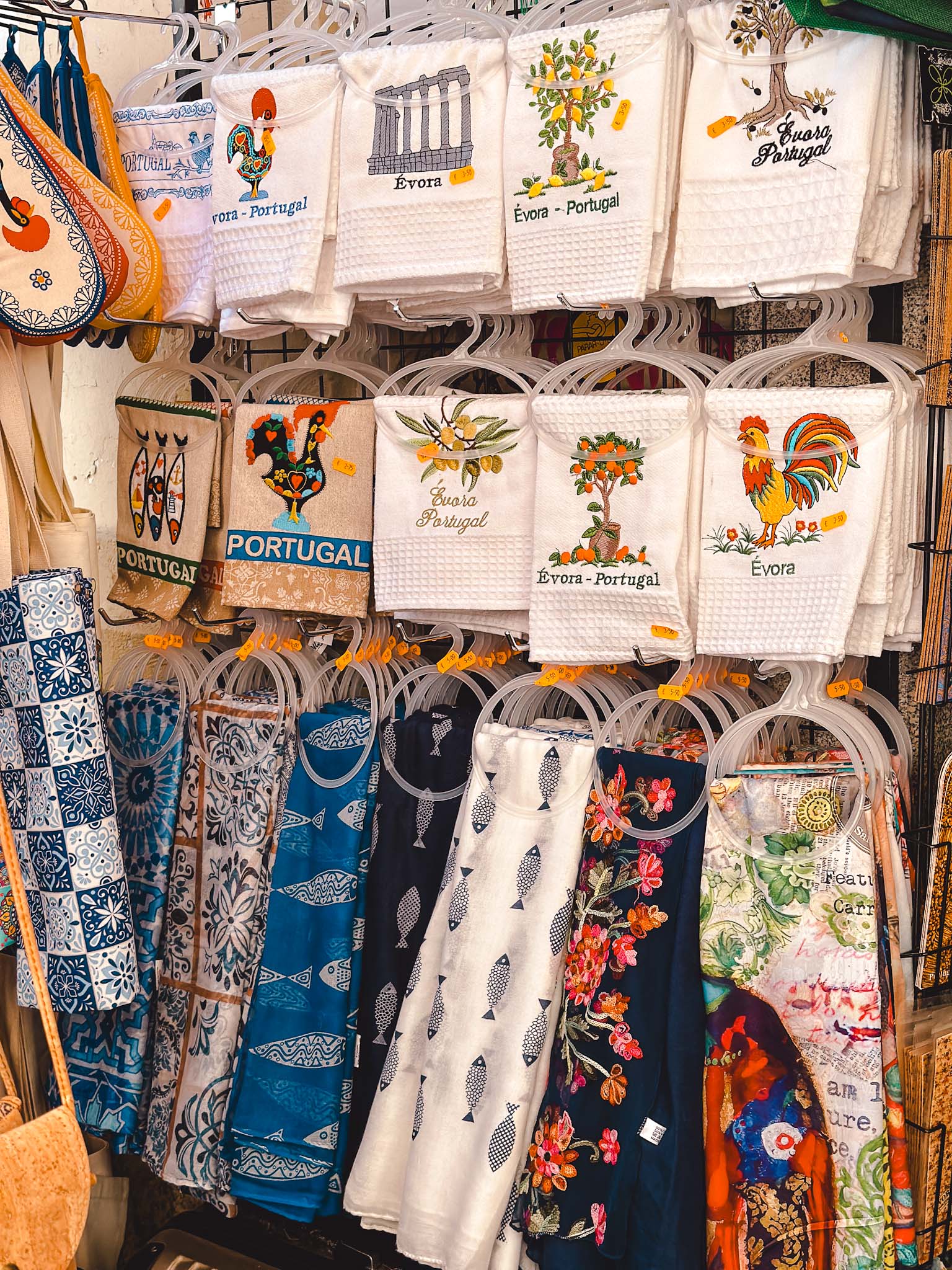

If you walk along Rua Cinco de Outubro street that starts at the square you will stumble upon narrow streets filled with souvenir shops, bars, cafés and restaurants. There were some people playing music on the streets and others sitting at the tables at the cafés.


Further down this street, we decided to have lunch at one of the nearby restaurants – Restaurante Páteo. it was a wonderful place as they have an inner courtyard where you can sit outside at the tables. I liked it!
Location: Praça do Giraldo – Restaurante Páteo
9. See the impressive Évora aqueduct!

If you drive to Évora by car, one of the first landmarks you’ll likely notice is the Évora aqueduct—an impressive 18-kilometer structure dating back to the 16th century, built to supply the city with water.
Known as Aqueduto da Água de Prata (Aqueduct of Silver Water), it was designed by the renowned Portuguese architect Francisco de Arruda, who also designed the famous Belém Tower in Lisbon.


As you walk inside the city, the aqueduct stretches deep inside the streets of Évora until it gets lower and lower and disappears into the ground. You can walk under the arches of the aqueduct until they get too low to walk through.
One of the best places to observe the massive aqueduct is at the parking lot next to the city walls. We parked our rental car right here and then walked to all the places on foot. You can park there for free.
Location: Aqueduto de Évora
10. Take a look at built-in houses inside the aqueduct!

One of the most unusual places in Évora that you can visit for free is this cool spot where you can see houses built inside the Évora aqueduct. The aqueduct goes along the street and locals have decided to use this opportunity wisely.
The wall of the house is aligned with the legs of the aqueduct. It looks pretty funny but it makes sense. Why not use extra stability for your house!? One of the cons is that you can’t really extend the house – it is as wide as the arch of the aqueduct and no more.
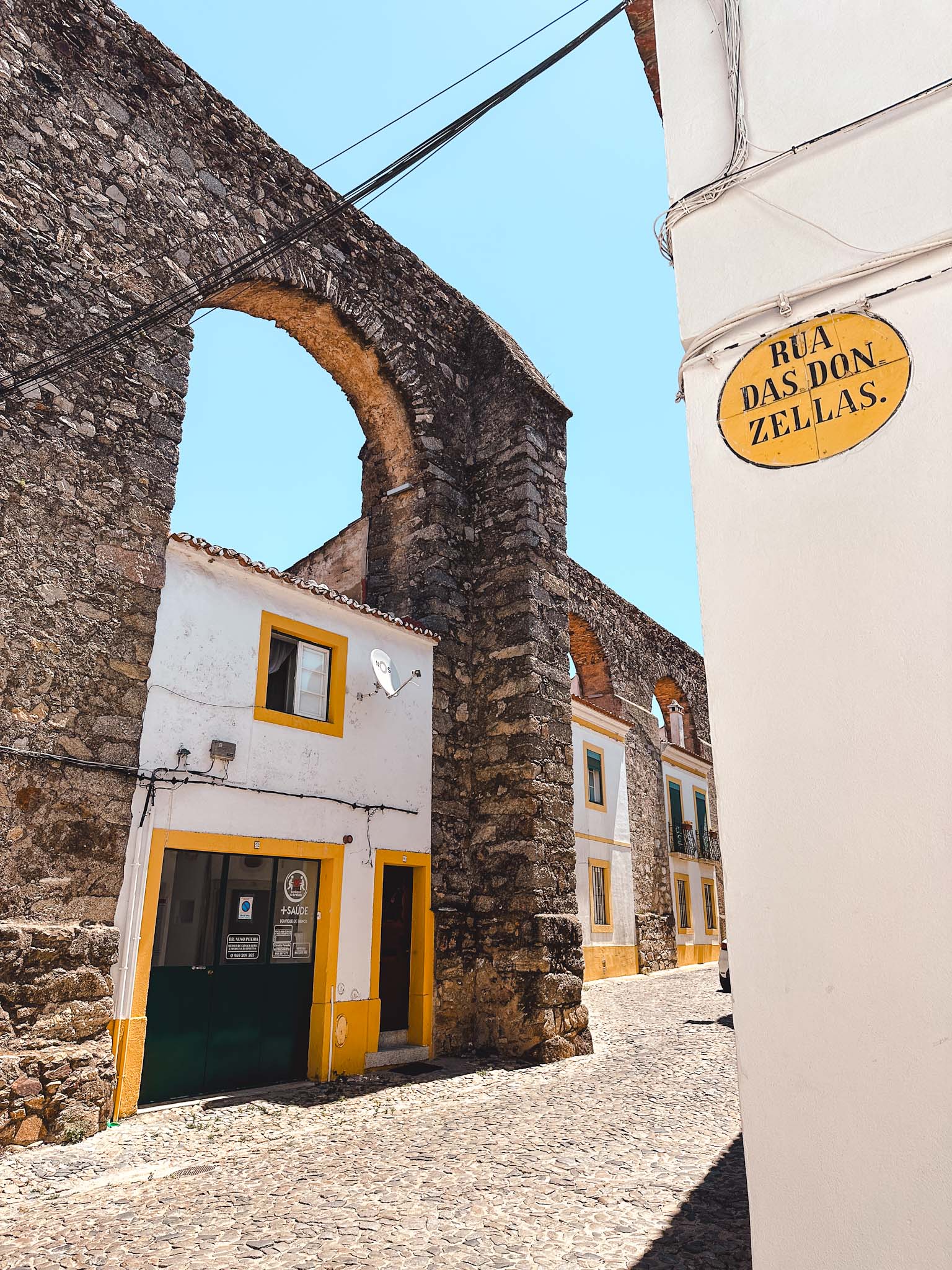

Not all of the arches are filled with houses as the aqueduct gets smaller and smaller. These houses are private so we did not enter them, but this is a pretty unique place so I highly recommend making a detour along these houses to check them out!
Location: Built-in houses inside the aqueduct
11. Stroll around the Royal Palace and garden of Évora!


In case you are looking for a relaxing place to stroll around or simply take a peaceful walk then the Garden of the Royal Palace of Évora is the perfect place to go. It offered us some very much welcomed shade from the summer heat!
The Garden of the Royal Palace of Évora, Jardim do Paço Real de Évora is a charming public garden located within the historical grounds of the Royal Palace of Évora.


The garden features many beautiful corners to discover. Apart from my favorite thing – peacocks – there is a former palace, a playground, ruins of a beautiful building, a fountain, a pergola, and many winding pathways leading through the lush garden.
This is not a must-see place, but if you have time and you are in the area, I recommend walking through the garden for a peaceful stroll and visiting the peacock family. The garden is also a popular place for events and festivals – maybe you catch one of them!
Location: Royal Palace of Évora
12. Stop by the architectural wonder – Igreja da Graça!

One of the most beautiful buildings in Évora is Igreja da Graça church. It is one of the most stunning architectural wonders you will see in Évora. Built in the 16th century in Renaissance architectural style it is a wonderful place to visit in Évora!
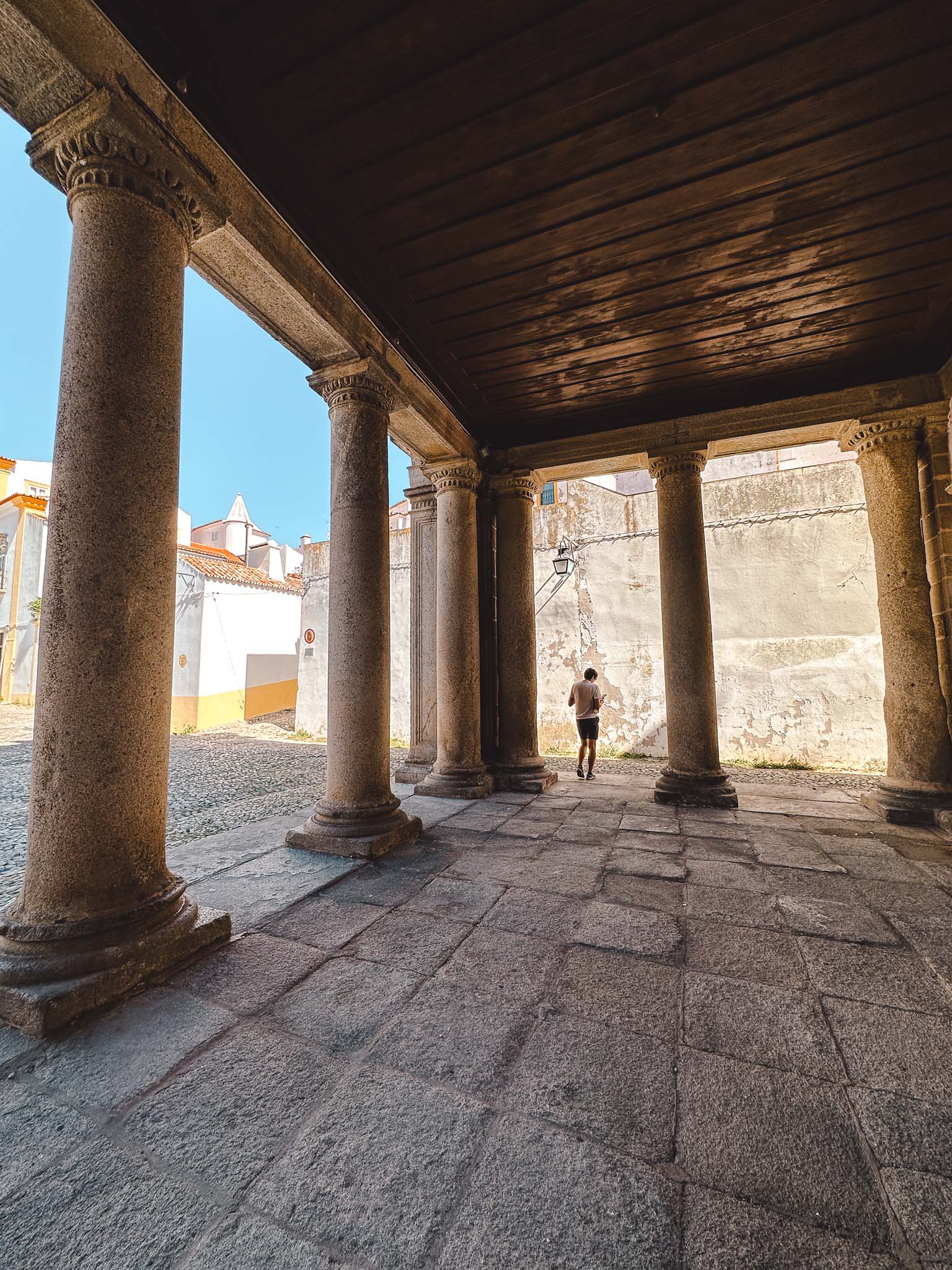
Unfortunately today the building serves for military purposes so it was not possible to enter the church and see the inside. However, the impressive Renaissance outside alone is enough of a reason to pay a short visit to this place!
Location: Igreja da Graça
13. Drive up to the windmill viewpoint of Alto de São Bento!

When you are done visiting the Historic Centre of Évora, there are a couple of spots near the city you should consider visiting! One of them is a beautiful panoramic viewpoint at the highest place near Évora – Alto de São Bento.
It is located less than a 10-minute drive away from the city and is the perfect place to watch the sunset in Évora as well as relax by nature. There are also remains of three white windmills that make this place unique and photogenic.


We only spent about 15 minutes here to take in the views and check out the windmills. If we had more time, I would wait for the sunset here. The hill is easy to get to as you can drive up to the top by car and park it at the side of the road near the summit.
Location: Alto de São Bento
14. Explore the ancient territory at Almendres Cromlech!


Another spot to visit near Évora is Almendres Cromlech. A cromlech is an ancient stone circle consisting of megaliths placed in a vertical position. These structures are believed to have been built as places of worship or burial sites.
This cromlech, located less than a 30-minute drive from Évora, is estimated to be more than 7,000 years old, making it about 3,000 years older than the famous Stonehenge. Access to Almendres Cromlech is public, and you can visit it for free.


To get there, you’ll have to drive a good stretch on gravel and dirt roads, but when we visited, the drive wasn’t too bad. The surrounding landscape is stunning, with vast plantations of Portugal’s famous cork trees—you can even see where their bark has been harvested.
Although Almendres Cromlech isn’t as imposing as Stonehenge, with its stones standing roughly the height of a human, it still has a striking and mysterious presence. Especially since so little is known or can be explained about ancient sites like this.
Location: Almendres Cromlech
15. Near Évora – stop by Castelo de Montemor-o-Novo!


In case you are going to Évora from Lisbon or you are going from Évora back to Lisbon, there is a cool place to stop by along that route—Castelo de Montemor-o-Novo.
Castelo de Montemor-o-Novo is a beautiful place on a hilltop where you can observe and walk around the remnants of a small village dating back to the Middle Ages as well as a striking hilltop castle.


It is believed that the construction of the castle started in the 13th century. The most notable thing about the castle is that Vasco da Gama finalized his plans for his famous sea voyage to India right here in this castle.
This was once a majestic castle with a village inside the fortress. However, over time it has all disappeared. Now you can walk around the remains of the castle, read about the past on information boards, and see the views from the hilltop castle remains.
The best part about it is that the entrance is free. You can walk around the area freely and explore everything you want to see. We went there on a hot day when nobody was around. It was a unique moment to be there next to the castle – a reminder of the past.
Location: Castelo de Montemor-o-Novo
16. Near Évora – explore Castelo de Monsaraz!
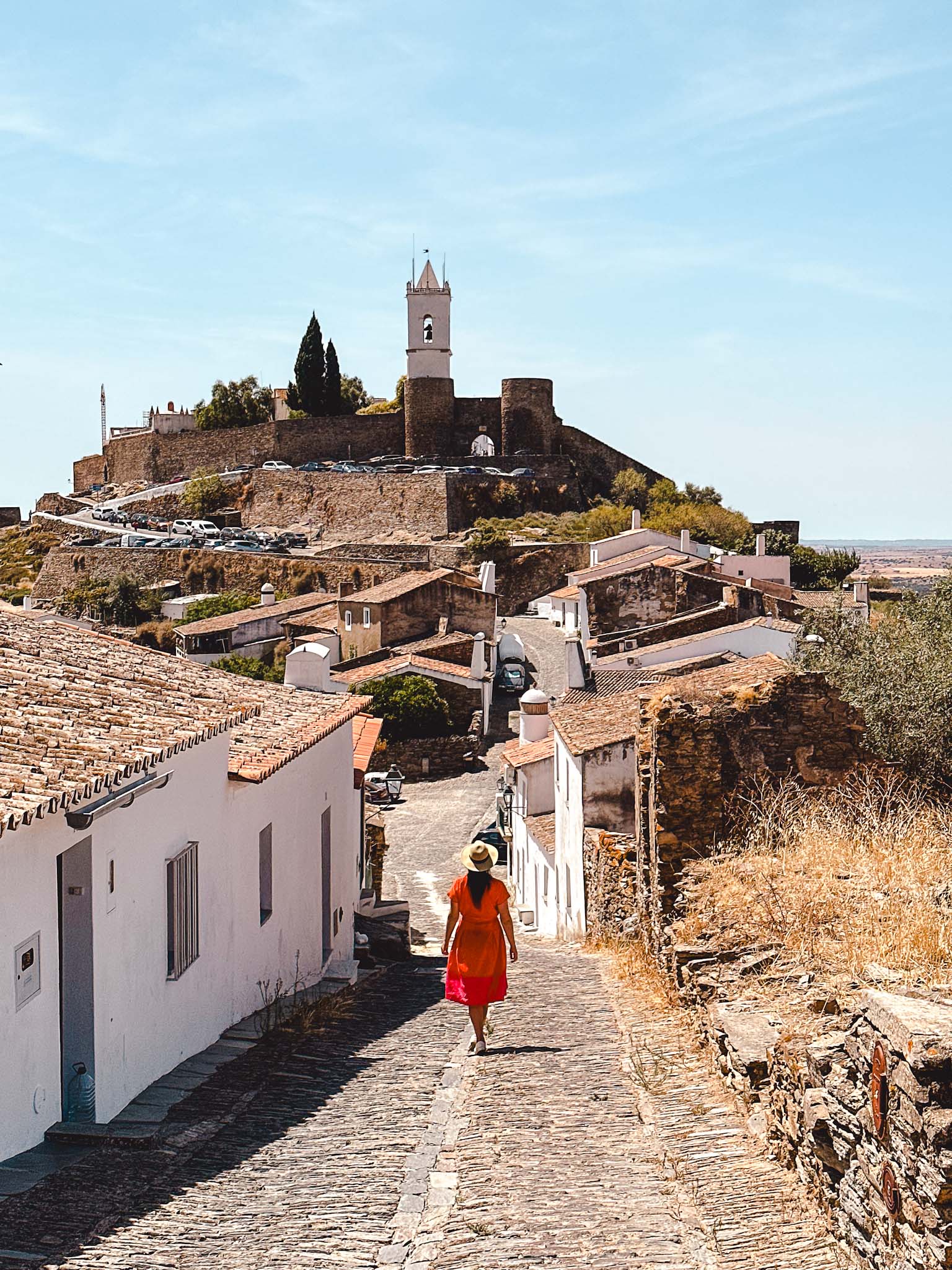
Monsaraz is a village in Évora district near the border of Spain. It sits on a hill and is one of the oldest settlements in southern Portugal. The most important landmark in Monsaraz is the medieval castle – Castelo de Monsaraz.
Due to its strategic location near the border and its advantageous position on a hill, it was once an important stronghold during many military conflicts that the country has experienced over the centuries. Monsaraz was under the rule of many different forces.


The imposing castle dates back to the 14th century. Much of what was built back then has still remained to this day. Walking around this medieval village felt like a time machine transporting me back in time.
You can visit the Castelo de Monsaraz for free. From the top of the castle walls, you will get amazing views over the surrounding area, especially the Alqueva water reservoir – the largest artificial lake in Western Europe.


There is not much left of the castle itself so the views over the area, climbing up to the defensive walls, and walking around them was the biggest fun we got. The inner enclosure of the castle today is used as a bullring.
I loved walking around the medieval village. It has whitewashed houses, narrow cobblestone streets, and stone defensive walls with only a couple of entrances, so you have to check where you can enter this fortification.
You can’t really drive inside the village, so you will have to park your car outside the walls and then climb up to the village on foot. See the parking location on Google Maps below. Monsaraz is a 50-minute drive away from Évora – a great detour if you have time!
Location: Castelo de Monsaraz – Parking lot
17. Near Évora – go on a trip to Elvas!


Just 1-hour drive away from Évora there is another authentic Portuguese city – Elvas. Although it is not in the Évora district, there are a couple of unique places that make this city a worthy destination while you are in the area.
Elvas lies on a hill just a couple of kilometers from the border of Spain. It is known for its unique star-shaped military architecture – bastion fort fortifications that are the largest bulwarked dry ditch system in the world. For this reason, Elvas is listed as a UNESCO World Heritage Site.


The whole historic center of Elvas is built inside massive fortifications. if you drive to the city, you will have to drive through a narrow gateway leading inside the fortifications. However, there are other smaller forts around the city.
Obviously, it is not possible to see the shape of the fort when you are at ground level. However, you can see the smaller forts on Google Maps if you switch on the satellite view. Look for Forte de Santa Luzia as well as Forte de Nossa Senhora da Graça.


You can also see the forts from afar – from the Castle of Elvas you can see one of the forts, Forte de Nossa Senhora da Graça. But if you go to Miradouro da Parada do Castelo viewpoint right next to the castle, you will spot the other fort as well.
Other places to visit in Elvas include the Castle of Elvas (there is 2 EUR entrance fee if you want to climb up to the walls and explore the watchtowers), the famous Arco de Santa Clara arch, Praça da República main square, and the massive Amoreira Aqueduct.
Location: Praça da República – Arco de Santa Clara – Castelo de Elvas – Forte de Nossa Senhora da Graça – Amoreira Aqueduct
Happy exploring!
Évora is a beautiful city in the heart of Portugal boasting beautiful architecture and rich historic heritage landing it a spot on the UNESCO World Heritage Site list. There are many iconic landmarks to explore in the city!
Main tourist magnets in Évora include the famous Chapel of Bones, the majestic Cathedral of Évora, and the ancient Roman Temple of Évora. These and many more places make Évora the perfect day trip destination from Lisbon or other places.
I hope you enjoy your time in Évora and Portugal as much as we did! And I hope you will get some travel inspiration from this blog post to make your trip to Évora even more exciting, memorable, and filled with lots of fun things!
PIN FOR LATER!


great article. Thanks so much.
Cheers, John! 🙂